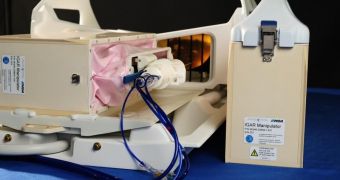Experts with the Center for Surgical Invention and Innovation (CSII), in Canada, announce the development of a new robot that can collect breast cancer biopsies with extreme precision, while also ensuring consistency between each sample.
The machine is based on the same technology that underlie the robotic arms in use aboard the International Space Station (ISS).
The robot, called Image-Guided Autonomous Robot, or IGAR for short, is based on numerous automated arms developed by the Canadian Space Agency (CSA) for the orbital laboratory. Instruments such as Canadarm-2 and Dextre played a pivotal role in assembling and operating the ISS.
Now, the know-how and expertise accumulated during all these years of development is being put to use in the field of medicine, with the development of the IGAR surgical robot. The machine can take very precise biopsies of breast cancer in a uniform manner, ensuring result consistencies across wide test subject groups.
IGAR collects data from the environment with its own sensors, but its readings are further augmented by a connection to a Magnetic Resonance Imaging (MRI) scanner. The latter provides high-resolution, 3D images of any part of the human body, allowing the robot to navigate to its target location easily and efficiently.
At this point, the new instrument is used to look for potentially harmful masses in the breast, which may hint at the development of breast cancer. MRI scanners are used to identify problem areas, and provide the first diagnosis. IGAR then conducts a needle biopsy based on those conclusions.
The robot currently has a level of precision of 8 millimeters (0.3 inches), meaning that it can be reliably used to insert a needle straight into dangerous formations in the human breast, explains the CEO and scientific director of the CSII, Dr. Mehran Anvari.
Doctors hope that using IGAR will save time, and reduce the pain usually associated with biopsy procedures, while also minimizing the costs. But the main advantage of using the robot is that it will produce consistent biopsies regardless of patients, cancer types and doctors.
“It also will allow all radiologists to perform this procedure equally well, regardless of the number of cases per year and move the site of treatment from operation room to radiology suite for a significant number of patients,” Anvar said in a recent statement quoted by Space.

 14 DAY TRIAL //
14 DAY TRIAL //